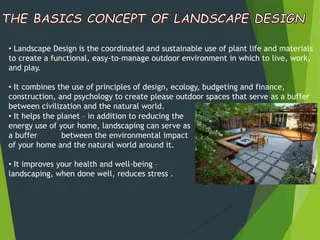Not known Facts About Landscape Design
Table of Contents7 Easy Facts About Landscape Design DescribedThe Best Guide To Landscape DesignHow Landscape Design can Save You Time, Stress, and Money.What Does Landscape Design Mean?
Official style motif. Credit Rating: Gail Hansen, UF/IFAS The yard is an extension of the home where a range of activities take area. A backyard can generally be separated right into 3 locations: public (the front lawn), exclusive (the back lawn), and solution (normally the side lawn). The area of activity locations depends primarily on the sort of location, the size of area needed, the type of task, and the preferred proximity to other tasks and frameworks (Landscape Design).
The outside wall of your home typically acts as the very first wall or starting point of an exterior space. Inappropriate uses should be separated, and relevant activities, such as cooking and dining, must be placed with each other to make the yard more reliable and delightful. When using hardscape to produce areas, make use of building material comparable to that utilized in your home for connection from your house into the yard.
Connected spaces. Credit Score: Gail Hansen, UF/IFAS Using comparable hardscape attributes and duplicating plants pulls the eye around the garden. Vital points along the road can be stressed with plantings or features that attract focus and encourage activity in a certain direction. Moving along the course takes an individual from one area to the following and allows the individual to have a selection of experiences.
From a layout perspective, plant materials have 3 major functions in the landscape: aesthetic, architectural and utilitarian. Aesthetically, plants produce an aesthetically pleasurable atmosphere and structurally plants organize and define areas.
Some Known Factual Statements About Landscape Design
For emotional comfort plants are used as physical or implied barriers for privacy and safety and security. Physical obstacles block both the view and access to a space and consist of fencings, wall surfaces and plant bushes.
Physical and suggested obstacles. Credit Score: Gail Hansen, UF/IFAS For these factors, the kinds of plants to be utilized (such as trees, bushes, or groundcovers) must be picked in the onset of planning. Plant types are selected for their practical capabilities to make sure that their future function and required space can be taken into consideration at the same time.
The overhanging airplane, the upright plane and the ground aircraft need to all be taken into consideration to develop enclosure. Once the form of a plant bed has been developed, the plants need to be massed (grouped) and split to attain aesthetic unity and the desired amount of room. The size of a plant mass will certainly depend upon the overall size of the lawn, the size of the individual plants in the mass, and the emphasis or effect wanted from the plant product.
Each plant mass is in front of, behind, or next to, an additional mass. Credit Score: Gail Hansen, UF/IFAS Repeating plants within a mass and duplicating masses with comparable plants links the yard with each other. The specific plant qualities should be taken into consideration to successfully layer and mass plants.
Some Known Incorrect Statements About Landscape Design
All plant structures begin with the main structure plants, the big, mostly evergreen background plants-such as the trees and big shrubs. These plants different or enframe areas, regulate the size of the space, and offer the beginning factor for picking blog here the suitable attributes of the 2nd layer, midground plants, for massing and infill.
Vital points in the garden must be highlighted by the use of distinct plants, distinctive frameworks, or yard ornaments. Marking limits or entrances to find out here now spaces can be finished with gates, arbors, and steps, or through making use of special and vibrant plants. The form and/or design theme of the garden will usually help identify the important points and how they should be highlighted.
Various other vital areas in the lawn are prime focus, which is utilized to aesthetically arrange a landscaped location. The type of centerpiece commonly depends upon the watching viewpoint. Different point of views or perspectives can expose various make-ups in the landscape that might need a selection of centerpieces. Contrasting structure, form, dimension and shade will record and hold the eye.
Some Of Landscape Design
Plant kinds. Credit Scores: Gail Hansen, UF/IFAS After kind, texture is the following leading feature of a plant; coarse, tool and fine appearances can be used for contrast and emphasis in the landscape.


The pleasant aroma of plants, the sound of wind in the trees, the sound and appearance of water, and the colors and textures of sculptures, pots and yard furnishings all contribute to the experience of the garden. One detail that is usually overlooked is the result of light on the visual appeals of the plants.
The entire garden changes in website link feature and look throughout the day, and the course of a year, as the light and temperature level modification from morning to night and season to season. Plant selection have to consider a plant's development price, its mature size and type, and the maintenance it will certainly need.
It is essential to recognize the eventual fully grown dimension of plants so they can be put in the right place and spaced properly when they are mounted. Offering plants room to expand is a difficulty since the usual mature size is commonly based upon optimal expanding problems and the ecological problems of a site may create a plant to grow bigger or stay smaller.